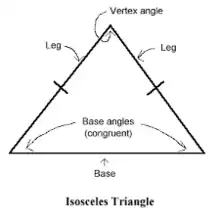< Geometry < Chapter 4 
Introduction
This lesson will go through Isoscolese Triangles and its principles.
Isocsolese Triangles

A labelled Isosceles Triangle
Isoscolese Triangles, as mentioned in Lesson 2, is a triangle that has at least 2 sides that are congruent. The congruent sides of an isoscolese triangle are the legs. The third side is the base. The two legs form the vertex angle. The other two angles are the base angles.
There are quite a few theroems that accommodate one's mind to understanding Isosceles Triangles, such as Theorems 4-1, 4-2, and 4-3:
Theorem 4-1
- If two sides of a triangle are congruent, then the angles opposite those sides are also congruent.
Theorem 4-2
- The bisector of the vertex angle of an isosceles triangle is the perpendicular bisector of the base.
Theorem 4-3
- If two angles of a triangle are congruent, then the sides opposite the angles are congruent. (Basically, Theorem 4-1 reversed)
This article is issued from Wikiversity. The text is licensed under Creative Commons - Attribution - Sharealike. Additional terms may apply for the media files.